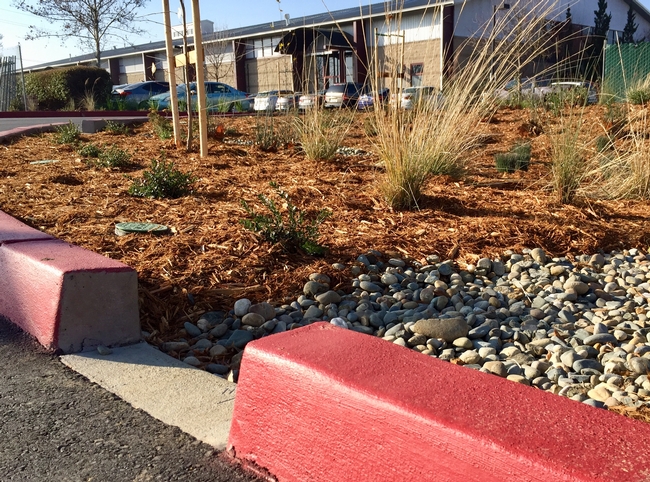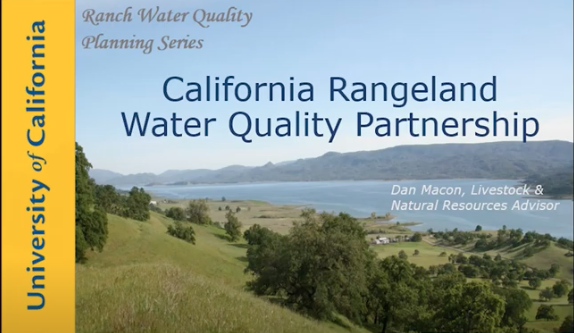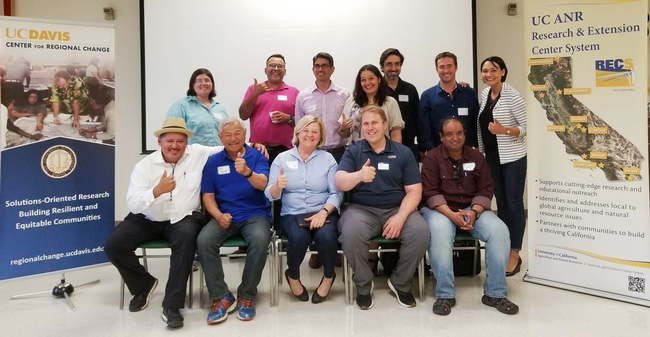- Author: Pamela Kan-Rice
The “Ranch Water Quality Planning Instructor's Guide and Lesson Plan” won the Association of Natural Resource Extension Professionals bronze award in the category of Book or Comprehensive Program Curriculum.
The team includes Toby O'Geen, Bill Birmingham, Brooke Latack, DJ Eastburn, Dan Macon, David Lewis, David Lile, Devii Rao, Fadzayi Mashiri, Jeffrey Stackhouse, Jim Downing, Josh Davy, Julie Finzel, Kenneth Tate, Laura Snell, Leslie Roche, Lucien Crowder, Matthew Shapero, Michael Lennox, Morgan Doran, Randy Dahlgren, Rebecca Ozeran, Rob Atwill, Sandra Osterman, Stephanie Larson, Theresa Becchetti and Tracy Schohr.
The Ranch Water Quality Planning Instructor's Guide and Lesson Plan represents the evolution of the UC Ranch Water Quality Planning Partnership and shortcourse program. The Instructor's Guide was published in two formats – a dynamic PDF document and an HTML webpage. Both formats integrate 29 educational and instructional videos in a curated playlist on the UC ANR YouTube channel. This comprehensive training resource gives instructors the tools to plan and deliver a shortcourse that trains private and public grazing land managers to develop land stewardship and water quality management plans. The Instructor's Guide provides a wealth of contemporary information and resources about water quality management on rangelands and supports adaptation of the curriculum content and elements to local conditions and needs. The team began outreach and extension of these resources in November 2020. Through January 2021, the materials were downloaded 110 times and received 240 unique page views.
- Author: Jonathan K. London
Linking UC Davis researchers with regional changemakers is core to the mission of the Center for Regional Change. One new program designed to achieve this goal is the Regional Change Public Dialogue series. The dialogue series, supported by a grant from the UC Davis College of Agricultural and Environmental Sciences, is intended to share cutting edge research from CRC-affiliated faculty with a diverse array of community leaders, as well as catalyze new research partnerships.
On May 11, the CRC hosted its third public dialogue at the Kearney Research Extension Center in the San Joaquin Valley town ofParlier. Kearney was an ideal site for this event as one of the experiment field stations that the University of California Agriculture and Natural Resources system dedicated to applied and solutions-oriented research.
[The event was streamed live on May 11 and recorded on Facebook https://www.facebook.com/UCDavisCRC.]
Complementing the agricultural and environmental focus of much of the Kearney projects, the research presented at the public dialogue focused on improving social, economic, health and political conditions in rural communities such as Parlier.
Keith Taylor, UC Cooperative Extension economic development specialist, introduced his research on cooperatives as engines of community economic vitality. Bernadette Austin, CRC associate director, presented the forthcoming work of UC Davis professors Anne Visser and Catherine Brinkley on agricultural and community sustainability in the Sacramento- San Joaquin Delta. I shared the new report, "The Struggle for Water Justice in the San Joaquin Valley."
Following the lightning talks, the participants -- including leaders in the agricultural, environmental justice, immigrant rights, economic development, transportation, and air quality sectors among others -- divided into discussion groups to highlight the key insights and potential applications of the research. Some of the most compelling ideas of the evening included developing a map to represent the relationships between water and social/economic/political power in the San Joaquin Valley and an action research agenda on rural cooperatives as a way to diversify and localize the regional agricultural economy.
Given the success of the Regional Change Public Dialogue series, the CRC will be seeking ideas and resources to expand the program in the future. We welcome your ideas on new directions!
Jonathan K. London, Faculty Director, Center for Regional Change
- Author: Pamela Kan-Rice
Construction of a new parking lot behind the ANR building in Davis is now complete. The new lot adds 92 full-size paved parking spaces and 40 parking spaces on gravel to the existing 96 spaces at 2801 Second St. The extra parking capacity will enable ANR to host more conferences at the building.
The new parking lot also provides a venue for UC ANR to demonstrate science at the site by integrating an ongoing water-quality research project.
“I'm so proud that we incorporated a science project in the parking lot for the urban horticulture and water researchers,” said Jan Corlett, chief of staff to the vice president, who is overseeing the project. “It demonstrates that science is in everything that UC ANR does, even in constructing a parking lot.”
The research project on the recently purchased 10 acres at 3031 Second St. was developed by Missy Gable, director of the Master Gardener Program; Loren Oki, UC Cooperative Extension specialist in environmental horticulture at UC Davis; Igor Lacan, UC Cooperative Extension urban forestry advisor for San Mateo and San Francisco counties; and Marq Truscott, a retired landscape architect, who lectures for the Landscape Architecture Program at UC Davis. The researchers will evaluate the effect of parking surfaces paved with different materials and coupled with rain garden swales on storm water runoff quality and quantity.
The study area of the parking lot features swales and three surfaces – asphalt, gravel and permeable pavers. The researchers will study how these features improve water quality by removing pollutants and reduce runoff by improving soil infiltration. They will be able to collect samples of runoff water from the different paved surfaces. In addition, all trees planted in the parking lot have engineered substrates to demonstrate the long-term effect on tree health and condition.
In the spring, a ribbon cutting ceremony will be held to celebrate the project.





